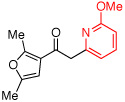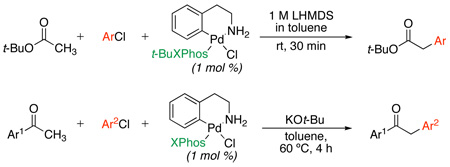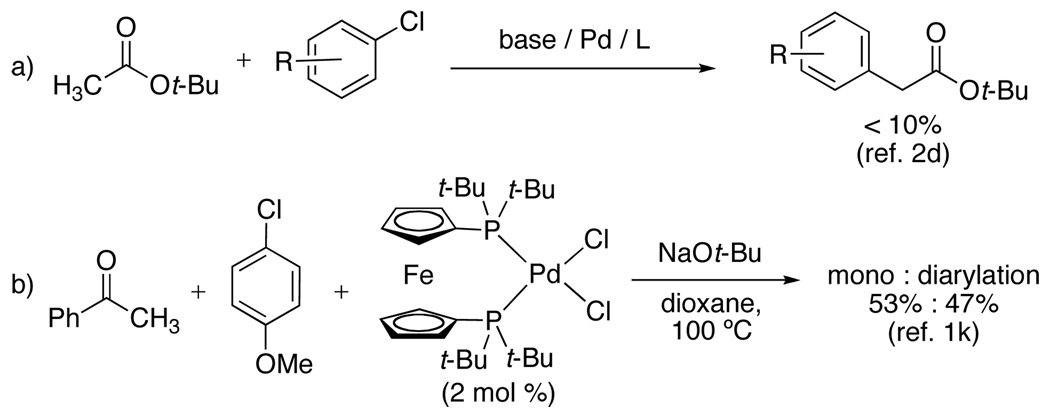Abstract
Simple, efficient procedures for the monoarylation of acetate esters and aryl methyl ketones using aryl chlorides are presented. Previously, no general method was available to ensure the highly selective monoarylation of these classes of substrates using aryl chlorides. Using palladium precatalysts recently reported by our group, these reactions are easily accomplished under mild conditions that tolerate a wide array of heterocyclic substrates.
It has been well demonstrated that the use of Pd-catalyzed α-substitution reactions of carbonyl compounds can be an effective strategy to achieve the arylation and vinylation of enolates,1,2 often with excellent enantiomeric control.3 However, there are very few reported examples of the selective monoarylation of enolates from acetate esters and methyl ketones using aryl halides or sulfonates where the enolate is not biased towards monoarylation by the presence of an ortho substituent on the aryl halide or by the presence of a pre-existing α-substituent on the enolate. Such α-arylation reactions are typically unsuccessful due to the instability of alkali ester enolates2d or the formation of significant amounts of diarylated side-products. To the best of our knowledge, the few examples of the monoarylation of t-butyl acetate that have been demonstrated separately by Hartwig2b,2c and our group2a using aryl bromides constitute the only examples of the direct monoarylation of acetate esters. In one recent report, when alkali metal enolates of acetate esters were employed with aryl chlorides, less than 10% of the desired α-arylated ester was observed (Scheme 1a).2d The corresponding zinc enolates were employed in an attempt to circumvent this problem, but the only reported examples utilized chlorobenzene and electron-deficient aryl chlorides as substrates. With regards to the monoarylation of aryl methyl ketones, there exist only a few reported examples that employ aryl halides lacking an ortho substituent.1e,1i A recent report highlighted the difficulty of preventing the formation of undesired diarylated products when the enolates of methyl aryl ketones are employed in cross-coupling reactions using aryl halides (Scheme 1b).1k
Scheme 1.
Previously, we reported a new class of palladium precatalysts for C–N cross-coupling reactions that is easily activated without the need for exogenous additives and ensures the formation of the corresponding monoligated active complex of Pd(0) (Figure 1).4 These biarylmonophosphine-ligated precatalysts intercept a competent catalytic cycle for C–N bond-formation at the amine complex, and are activated after deprotonation by the base intrinsically necessary for the cross-coupling reaction. Since base is also required for the α-arylation of carbonyl enolates, we have begun to investigate the use of these precatalysts as convenient Pd sources for conducting such C–C cross-coupling reactions under mild conditions.5 Herein we report simple, efficient procedures to effect the α-arylation of acetate esters and aryl methyl ketones with aryl chlorides using precatalysts bearing biarylmonophosphine ligands. We believe that the success of these reactions results largely from the high activity of the L1Pd(0) species generated by our precatalysts and the related ability to conduct the reactions under very mild conditions.
Figure 1.
Formation of L1Pd(0) complexes bearing biarylphosphines
We have found that precatalysts bearing bulky biarylmonophosphine ligands 1 and 2 (3 and 4, respectively) can efficiently promote the α-arylation of t-butyl acetate. Although 3 and 4 can both promote the α-arylation reaction, the use of 4 is necessary to obtain selective monoarylation of the acetate ester. Table 1 displays a series of monoarylated t-butyl acetates that were prepared from the direct α-arylation of t-butyl acetate. These reactions occur efficiently using aryl and heteroaryl chlorides and t-butyl acetate at room temperature with 1 mol % 4 and a commercailly available solution of 1 M LHMDS in toluene. No solvent other than that from the LHMDS solution is necessary. In general, these reactions are complete in less than 30 min. However, more difficult aryl chlorides (entries 9 and 10) require longer reaction times. The electronic nature of the aryl chloride had little effect on the success of the cross-coupling reaction; reactions involving 4-chlorotoluene (entry 1) and 4-chlorodimethylaniline (entry 3) each proceeded efficiently in less than 30 min. For reactions involving highly reactive aryl chlorides (entries 5 and 7), the temperature had to be reduced to 0 °C to preclude the formation of bisarylated products. Even at 0 °C, these reactions were complete in approximately 30 minutes. Because our precatalysts are easily activated well below 0 °C, they constitute powerful palladium sources for such low temperature cross-coupling reactions.6
Table 1.
Selective Monoarylation of t-Butyl Acetate Using Aryl and Heteroaryl Chloridesa
 | |||||
|---|---|---|---|---|---|
| entry | product | yieldb (%) | entry | product | yieldb (%) |
| 1 |  |
95 | 6 |  |
90 |
| 2 |  |
90 | 7 | 87c | |
| 3 | 90 | 8 | 88 | ||
| 4 |  |
95 | 9 |  |
92d |
| 5 | 92c | 10 |  |
85e | |
Reaction conditions: aryl chloride (0.5 mmol), t-butyl acetate (0.75 mmol), 1 M LHMDS (1.5 mL, 1.5 mmol) at rt for 30 min.
Isolated yields (average of two runs).
Reaction conducted at 0 °C.
4 h reaction time.
14 h reaction time.
We propose that our ability to monoarylate the lithium enolate of t-butyl acetate arises from a combination of three factors: 1) the use of a bulky ligand that retards subsequent bisarylation of the monoarylated product; 2) the use of a precatalyst that rapidly forms a highly active L1Pd(0) complex and results in the rapid conversion of the starting material, preventing competitive background Claisen reactions and the decompostition of potentially unstable metal enolates;2d and 3) the use of low temperatures, which favors monoarylation in these cross-coupling reactions. All three of these reaction properties are readily accessed through the use of precatalyst 4 as the palladium/ligand source. At present, monodentate ligands provide better results than those obtained with bidentate ones. However, it is possible that bidentate ligands whose use provides similar (or better) results may be discovered.
While the use of t-BuXPhos (2) was required to achieve the selective monoarylation of t-butyl acetate using aryl chlorides, XPhos (1) proved to be the optimal ligand for the monoarylation of aryl methyl ketones (Table 2). Using precatalyst 3 and KOt-Bu7 in toluene at 60 °C, the monoarylation reactions are complete in less than 4 h. The reaction tolerates a variety of heterocyclic moieties in both the aryl chloride and the aryl methyl ketone. Previously, there have been few reported examples of analogous Pd-catalyzed α-arylation reactions that employ either heteroaryl methyl ketones (entries 2, 3, 5, 10) or heteroaryl halides (entry 6). With this protocol, various acetyl furans, acetyl thiophenes, and acetyl pyridines can be succesfully monoarylated. Using precatalyst 3,8 monoarylation products can also be obtained in good yields where both heteroaryl acetyls and heteroaryl chlorides are employed together (entries 7–9, 11). Efforts to arylate heteroaryl methyl ketones whose heteroaryl groups possess two or more heteroatoms (e.g., thiazoles, imidazoles, pyrazines, and triazoles) were largely unsuccessful. When the α-arylation of an aryl methyl ketone is conducted in the presence of an acetamide group, complete selectivity for the arylation of the ketone enolate is observed over the amide enolate (entry 12). Again, the use of a bulky, biarylphosphine ligand permits selective monoarylation, while the use of a highly active Pd source permits the cross-coupling reactions to be conducted under mild conditions.
Table 2.
Selective Monoarylation of Aryl and Heteroaryl Acetyls Using Aryl and Heteroaryl Chloridesa
 | |||||
|---|---|---|---|---|---|
| entry | product | yieldb (%) | entry | product | yieldb (%) |
| 1 |  |
89 | 7 |  |
76 |
| 2 |  |
88 | 8 |  |
85 |
| 3 |  |
81 | 9 |  |
79 |
| 4 |  |
97 | 10 |  |
84 |
| 5 |  |
90 | 11 |  |
82 |
| 6 |  |
90 | 12 |  |
86 |
See Supporting Information for general procedures.
Isolated yields (average of two runs).
In summary, we have developed operationally-simple, efficient methods for the selective monoarylation of acetate esters and aryl methyl ketones. These methods employ readily activated precatalysts bearing bulky biarylmonophosphine ligands in order to effect monoarylation under mild conditions. In each case, the reactions largely tolerate the presence of heteroaromatic substituents. The success of these reactions further demonstrates the advantages of conducting Pd-catalyzed cross-coupling reactions using metallacyclic precatalysts such as 3 and 4. Such precatalysts permit Pd activation under mild reaction conditions and in the absence of competitive residual ligands such as dba or PPh3 that are typically used to stabilize Pd(0) precursors.
Supplementary Material
Experimental procedures and spectral data for all products. This information is available free of charge via the Internet at http://pubs.acs.org.
Acknowledgment
We thank the National Institutes of Health (NIH) for support (GM-46059). M. R. B. thanks the NIH for a postdoctoral fellowship (GM-F32-75685). We also thank Merck, Boehringer Ingelheim, and Nippon Chemical for unrestricted funds.
References
- 1.For ketones see: Palucki M, Buchwald SL. J. Am. Chem. Soc. 1997;119:11108. Hamann BC, Hartwig JF. J. Am. Chem. Soc. 1997;119:12382. Satoh T, Kawamura Y, Miura M, Nomura M. Angew. Chem. Int. Ed. 1997;36:1740. Kawatsura M, Hartwig JF. J. Am. Chem. Soc. 1999;121:1473. Fox JM, Huang X, Chieffi A, Buchwald SL. J. Am. Chem. Soc. 2000;122:1360. Nguyen HN, Huang X, Buchwald SL. J. Am. Chem. Soc. 2003;125:11818. doi: 10.1021/ja036947t. Culkin DA, Hartwig JF. Acc. Chem. Res. 2003;36:234. doi: 10.1021/ar0201106. Viciu MS, Kelly RA, Stevens ED, Naud F, Studer M, Nolan SP. Org. Lett. 2003;5:1479. doi: 10.1021/ol034264c. Navarro O, Marion N, Oonishi Y, Kelly RA, Nolan SP. J. Org. Chem. 2006;71:685. doi: 10.1021/jo0521201. Huang J, Bunel E, Faul MM. Org. Lett. 2007;9:4343. doi: 10.1021/ol7019839. Grasa GA, Colacot TJ. Org. Process Res. Dev. 2008;12:522. Marion N, Ecarnot EC, Navarro O, Amoroso D, Bell A, Nolan SP. J. Org. Chem. 2006;71:3816. doi: 10.1021/jo060190h. Carril M, SanMartin R, Dominguez E, Tellitu I. Tetrahedron. 2007;63:690.
- 2.For esters see: Moradi WA, Buchwald SL. J. Am. Chem. Soc. 2001;123:7996. doi: 10.1021/ja010797+. Lee S, Beare NA, Hartwig JF. J. Am. Chem. Soc. 2001;123:8410. doi: 10.1021/ja016032j. Hama T, Hartwig JF. Org. Lett. 2008;10:1545. doi: 10.1021/ol8002578. Hama T, Hartwig JF. Org. Lett. 2008;10:1549. doi: 10.1021/ol800258u.
- 3.(a) Chieffi A, Kamikawa K, Ahman J, Fox JM, Buchwald SL. Org. Lett. 2001;3:1897. doi: 10.1021/ol0159470. [DOI] [PubMed] [Google Scholar]; (b) Hamada T, Chieffi A, Ahman J, Buchwald SL. J. Am. Chem. Soc. 2002;124:1261. doi: 10.1021/ja011122+. [DOI] [PubMed] [Google Scholar]; (c) Liao X, Weng Z, Hartwig JF. J. Am. Chem. Soc. 2008;130:195. doi: 10.1021/ja074453g. [DOI] [PMC free article] [PubMed] [Google Scholar]
- 4.Biscoe MR, Fors BP, Buchwald SL. J. Am. Chem. Soc. 2008;130:6686. doi: 10.1021/ja801137k. [DOI] [PMC free article] [PubMed] [Google Scholar]
- 5.(a) Fors BP, Watson DA, Biscoe MR, Buchwald SL. J. Am. Chem. Soc. 2008;130:13552. doi: 10.1021/ja8055358. [DOI] [PMC free article] [PubMed] [Google Scholar]; (b) Martin R, Buchwald SL. Org. Lett. 2008;10:4561. doi: 10.1021/ol8017775. [DOI] [PMC free article] [PubMed] [Google Scholar]
- 6.A water-mediated preactivation protocol that we recently reported could also be used to access an active L1Pd(0) complex for use at room temperature. See: Fors BP, Krattiger P, Strieter E, Buchwald SL. Org. Lett. 2008;10:3505. doi: 10.1021/ol801285g.
- 7.It was found empirically that the use of NaOt-Bu resulted in the formation of significantly greater amounts of diarylated products.
- 8.Precatalyst 3 is currently available from Strem (item #: 46–0268). We expect 4 to be available in the near future.
Associated Data
This section collects any data citations, data availability statements, or supplementary materials included in this article.
Supplementary Materials
Experimental procedures and spectral data for all products. This information is available free of charge via the Internet at http://pubs.acs.org.





